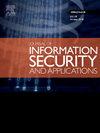基于速率分裂极化码的秘密密钥协议
IF 3.7
2区 计算机科学
Q2 COMPUTER SCIENCE, INFORMATION SYSTEMS
Journal of Information Security and Applications
Pub Date : 2025-06-13
DOI:10.1016/j.jisa.2025.104119
引用次数: 0
摘要
为了防止非法传感器探测到水声信道(UAC)中的秘密密钥协议过程,提出了一种基于速率分裂极化码(RSPC)的秘密密钥协议方案。首先,根据UAC的衰落过程,由发送端建立并计算新的Bhattacharyya参数进行编码构建;然后通过对极化子信道的可靠性排序来选择信息集。其次,发送端通过分频和极化编码得到两个独立的码字;然后,基于一阶自回归模型、Wiener-Khinchin定理和Karush-Kuhn-Tucker (KKT)条件设计了一种UAC增益预测算法。基于速率分割和预测算法,将极化子信道的索引集分为随机集和确定性集,并在一个码字的高熵位与另一个码字的低熵位之间进行按位异或运算。该策略提高了UAC中码字传输的隐蔽性。根据传感器观测和信道增益,通过逐次对消译码获得码字估计,接收端可以提取相同的密钥。最后,对RSPC方案的可靠性、隐密性和隐密密钥生成率进行了理论分析。仿真结果表明,与现有方案相比,RSPC方案的上述性能指标分别提高了21.26%、47.19%和24.71%。同时,RSPC方案生成的秘钥成功通过NIST的随机性检测。本文章由计算机程序翻译,如有差异,请以英文原文为准。
Covert secret-key agreement based on rate-splitting polar code
In order to prevent illegal sensors from detecting the secret-key agreement process in the underwater acoustic channel (UAC), a covert secret-key agreement scheme based on rate-splitting polar code called RSPC is proposed. Firstly, a novel Bhattacharyya parameter is established and calculated by the transmitter for code construction according to the fading process of the UAC. The information set is then selected by sorting the reliability of the polarized sub-channels. Secondly, two independent codewords are obtained by the transmitter through rate-splitting and polar coding. Then, an UAC gain prediction algorithm is designed based on the first-order autoregressive model, Wiener–Khinchin theorem and Karush-Kuhn–Tucker (KKT) condition. Based on the rate-splitting and prediction algorithm, the index set of the polarized sub-channels is divided into a random set and a deterministic set, and the bitwise XOR operation is performed between the very high entropy bits of one codeword and the low entropy bits of the other codeword. This strategy improves the covertness of the codeword transmission in the UAC. According to the sensor-based observation and channel gain, the estimate of the codeword is obtained via successive cancellation decoding and the same secret-key can be extracted by the receiver. Finally, theoretical analyses are conducted on the reliability, covertness, and covert secret-key generation rate of the RSPC scheme. The simulation results show that compared with existing schemes, the RSPC scheme improves the above performance indicators by 21.26%, 47.19%, and 24.71%, respectively. Meanwhile, the secret-key generated by the RSPC scheme successfully passes the NIST randomness detection.
求助全文
通过发布文献求助,成功后即可免费获取论文全文。
去求助
来源期刊

Journal of Information Security and Applications
Computer Science-Computer Networks and Communications
CiteScore
10.90
自引率
5.40%
发文量
206
审稿时长
56 days
期刊介绍:
Journal of Information Security and Applications (JISA) focuses on the original research and practice-driven applications with relevance to information security and applications. JISA provides a common linkage between a vibrant scientific and research community and industry professionals by offering a clear view on modern problems and challenges in information security, as well as identifying promising scientific and "best-practice" solutions. JISA issues offer a balance between original research work and innovative industrial approaches by internationally renowned information security experts and researchers.
 求助内容:
求助内容: 应助结果提醒方式:
应助结果提醒方式:


